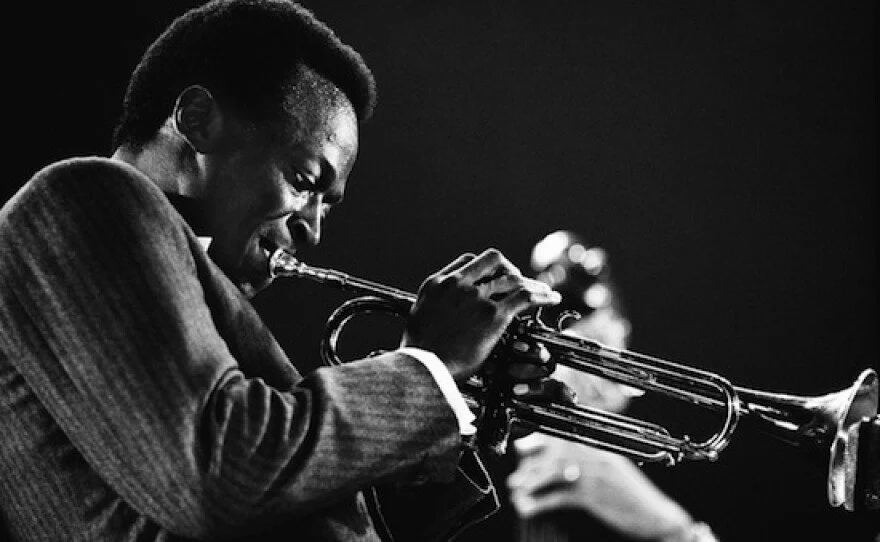Episode 3: The Artistry of a Jazz Solo
Let’s go back to that old favorite, “Satin Doll,” here played by a trio featuring pianist McCoy Tyner.
As we’ve seen, “Satin Doll” is a song in AABA form. Tyner (along with bassist Steve Davis and drummer Lex Humphries) starts by playing the “head”—the original melody—with the drums and bass backing him (0:00 to 1:05). Then he begins to solo, and notice how each section of the song—each 8-bar phrase—has a distinctive style and approach. The first “A” section starts with a simple motif that’s repeated a few times before some rapid passagework (1:06-1:22). The next “A” section uses another motif, a little more complex, that ends with another rapid string of notes leading into the next section (1:23-1:37). The intensity builds a little in the “B” section, which starts with some block chords (rather than strings of single notes) and then moves into more strings of notes before transitioning to the final “A” section (1:38 to 1:53). This section starts by bringing back the same little motif that began the solo at 1:06, and builds on that to work back to the beginning of the song (1:54-2:09).
Tyner’s solo lasts three choruses—three times through the entire AABA song. But each section has its unique quality. He typically starts with a simple musical idea that he repeats a few times and then expands on it in the last part of the section. In the final “B” section (3:45-4:01), for example, he starts out with a simple 3-note figure and then explores different variations on it. Other sections start with a similar idea, explore it a little, but then move on to some rapid runs of notes or a string of block chords.
To hear more how great jazz players craft a solo, let’s look at “Milestones,” a classic 1958 by Miles Davis with his sextet.
“Milestones” is an example of “modal jazz” (more on that in a later episode). The song—composed by Davis—doesn’t move through a series of several chords as “Satin Doll” does. Instead, it uses two tonal centers, or modes. Its form is a little different than the 32-bar song form—it repeats the “B” section, so the real form is AABBA. The “A” section is basically eight bars of the same mode. It’s repeated twice. The “B” section is centered on a different mode (you can hear the harmony jump up a “half-step” at the change), and has a slightly different feeling. The beat stays constant, but it seems to “float” a little without driving as hard. The “A” section returns once before the solos.
The first soloist is Julius “Cannonball” Adderley (0:39) He starts out with a bluesy figure and repeats as it climbs up the scale, then continues with a rapid string of notes that uses syncopation (phrases with accents in unexpected spots) to create little surprises along the way. When he moves into the “B” section (0:55), he eases up, following the “float” mood. But when the “A” section approaches (1:05), he grabs onto the rhythm again and charges ahead to the end of the chorus.
”Rhythm” is on Canononball’s mind as he starts soloing in the second chorus. He uses quotes from Gershwin’s “Fascinating Rhythm” several times through the “A” section (1:20; 1:29). He plays around outside the steady beat in the “B” section. Then once again, builds momentum to drive into rhythm in the final “A” section, closing out his solo with a figure similar to the one he used to start it.
And that is exactly where Miles Davis starts when he begins his solo (1:59). Miles quotes Adderley’s final motif, and repeats and varies it to move the music forward. It’s a great example of how players listen to each other and build on each other’s ideas. Miles’s solo is a study in economy. He doesn’t wow us with rapid strings of notes, but instead chooses simple motifs and then toys around with them. He concludes his solos with a little figure that is—once again—taken up by the next soloist, John Coltrane (3:20). But Coltrane immediately makes the figure his own, transforming Miles’s little five-note figure into a rising cascade of notes.
Miles Davis
The contrast between Davis’s and Coltrane’s solos is a great example of personal jazz styles. Davis’s solo is comparatively spare and precise, as if he knows exactly where he wants the notes to land. Coltrane’s by contrast is more loose and exploratory, as if he’s testing to see how far he can stretch the harmonies chugging along in the rhythm.
That’s one of the primary joys of listening to jazz—hearing how individual musicians express their personalities and ideas over the course of the same musical framework.



